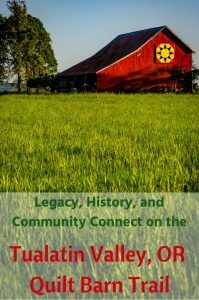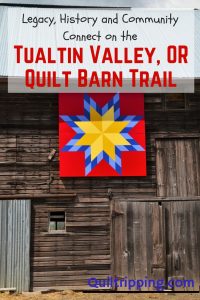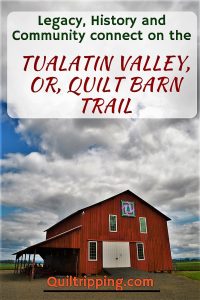Last Updated on 11/16/20 by Rose Palmer
Barns and quilts. Both of these represent unique aspects of America’s traditional farming heritage. Today, old barns and old quilts are lovingly preserved as a link to a slowly disappearing lifestyle. What better way to foster awareness of America’s legacy and history than a Quilt Barn (or Barn Quilt) Trail through the rural landscape.
The Tualatin Valley’s Quilt Barn Trail Beginnings
Julie Mason discovered the barn quilts of the Midwest on a RV vacation with her husband. As a quilter herself, she was fascinated by these large wooden panels painted with a quilt block design and then hung on the side of a barn as decoration.
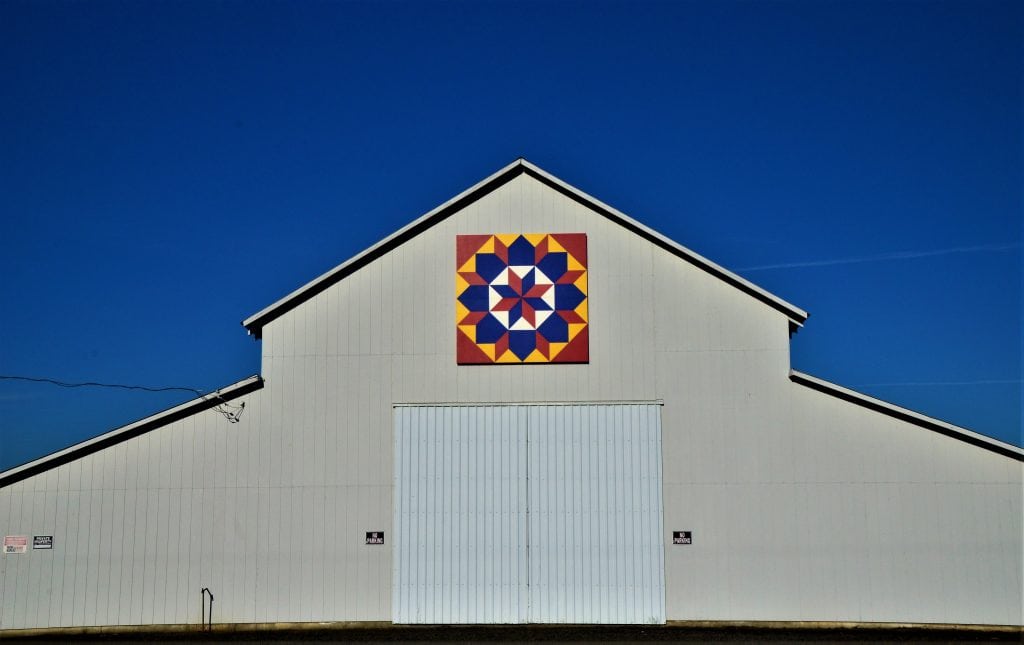
The barn quilt practice started in Adams County, Ohio in 2001 by Donna Sue Grove. Donna Sue wanted to honor her mother’s Appalachian quilting heritage with a painted quilt block to hang on the Grove’s family tobacco barn. That idea grew from one block into the eventual execution of a collection of 20 blocks to form a driving trail for visitors to Adams county. The hope was that it would help promote more tourism into a county that also drew visitors with its Amish and Appalachian attractions.
From Adams county, the barn quilt movement quickly expanded into neighboring Brown County, and then into the states of Tennessee and Kentucky. Today, 48 states and some areas in Canada are hosts to barn quilt trails, promoting explorations of the rural landscape while showing off a uniquely American craft.
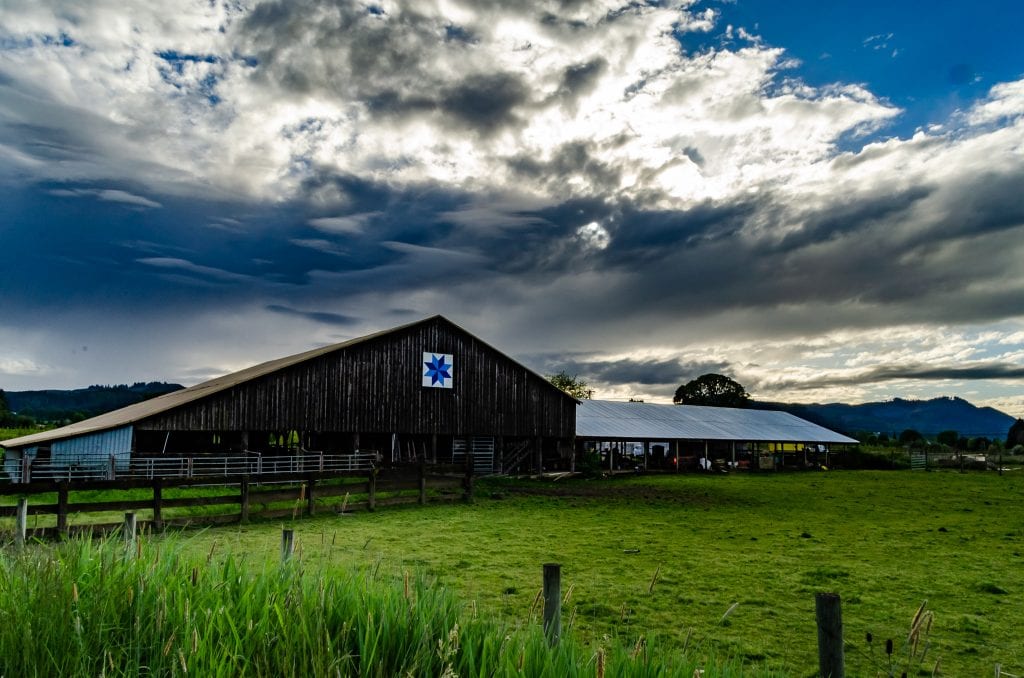
Coming back home to Oregon, Julie Mason felt that Washington County’s highly rural Tualatin Valley would also benefit from a barn quilt trail. The county, which is part of the greater Willamette Valley, has a long agricultural history with many of the farms being settled during the Oregon Trail migration of the mid to late 1800’s. The ties to that pioneering family heritage are still strong in the valley today. The county has almost 100 “century farms” as well as quite a few farms that have approved “sesquicentennial (150 years)” status. Receiving a “century” or “sesquicentennial” farm status is not just a token title. It involves a formal application process with the state that demonstrates that the same piece of land has been actively owned and farmed by the same family for the past 100 or more years. Julie recognized that a barn quilt trail in her county could showcase this rich farming heritage and increase tourism to the area, while also acting as a platform for public art.
Being actively involved in her local quilting guild, Julie presented the idea of a barn quilt trail, (or as she chose to call it, a quilt barn trail) to the Westside Quilter’s Guild in 2012. The guild agreed to sponsor the project, but that was just the first, easy hurdle.
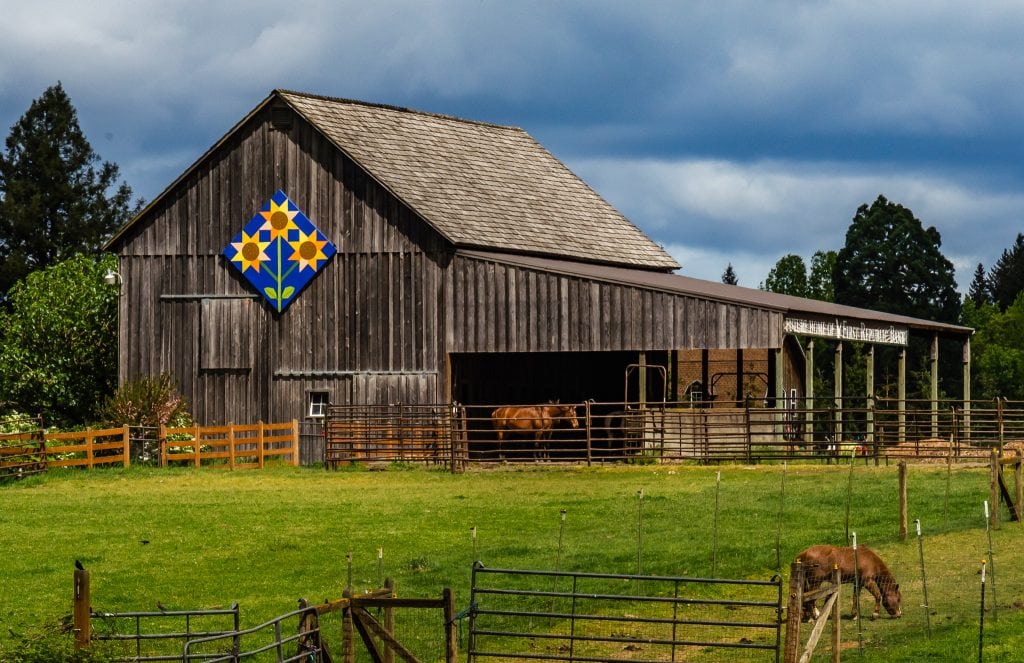
It turned out that in Washington County, as in much of the American west, there was a strict sign ordinance against putting up large public signs. Even though the barns are private property, hanging up an 8 ft square block on the side of a barn fell under this regulation. Julie and her team did not give up though. Two years and four hearings later, the sign ordinance was rewritten so that quilt blocks could be hung on the local barns. Of course, there were some conditions: the blocks had to be hand painted, they could not be larger than 8 ft x 8 ft, and they had be hung outside the area’s urban growth boundary. Most importantly, it needed to be a completely voluntary process, including the funding.
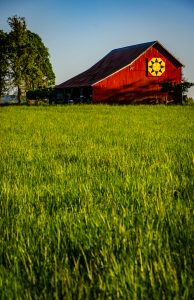
As they were cutting through the governmental red tape, Julie and her team put those two years to good use. Fellow quilt guild member Jane Fouste did a national survey of established quilt barn trails and got back a lot of helpful information that helped the team to prepare. To pay for materials and installation, they worked on getting grants, donations and sponsors, including the Washington County Visitor’s Association. They also began figuring out the construction details, deciding on elements such as block size, type of wood, kind of paint, etc.
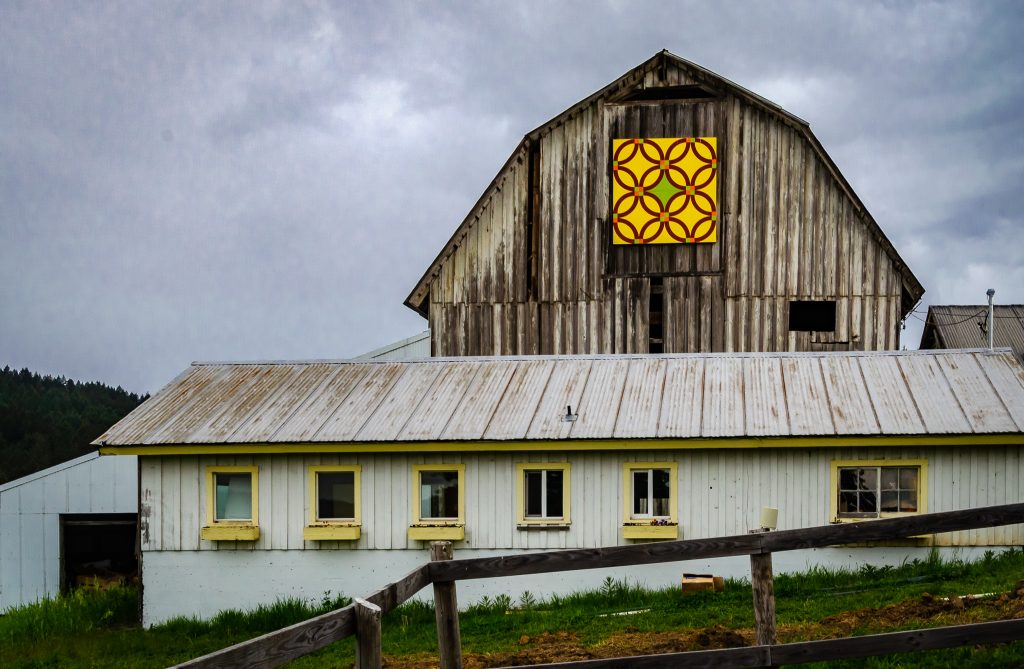
The first colorful barn quilt block finally went up on Dec. 5, 2014 on the Simpson Century Farm. The Simpson family has owned and worked this farm since 1878. They chose a traditional block that was created by the women crossing on the Oregon Trail, called “Hovering Hawks”. Though the farm is over 100 years old, sadly, the original barn was destroyed in the big 1962 Columbus Day storm, and was replaced by the current version.
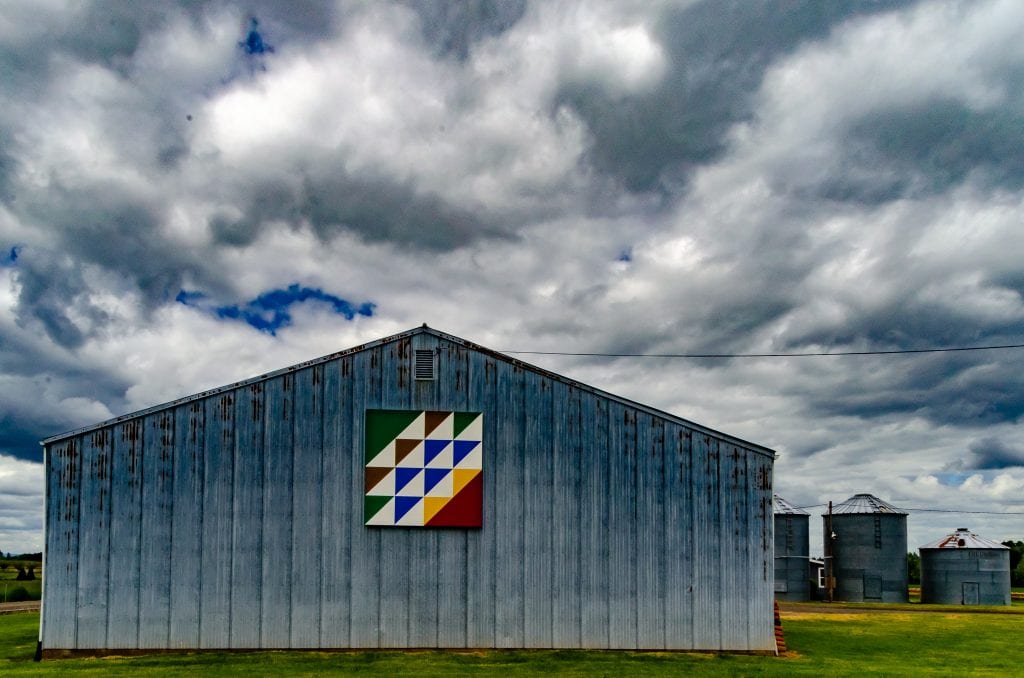
By the end of 2015, the Quilt Barn Trail team of volunteers had put up a total of 16 blocks. When I met with Julie Mason and Jane Fouste in May, 2018 to hear the story of how they established their quilt barn trail, they were getting ready to put up blocks no. 49 and 50, with a final goal of about 60 quilt barn blocks on the trail.
These blocks are more than just a pop of color on the side of a barn though. Pretty as they are to look at, for each farm where they hang, the blocks represent a piece of that farm’s history. Many of the blocks hang on barns that are part of century farms, so the blocks serve as a visual story of that family’s long legacy. In some cases, the quilt barn block clearly depicts the crop that particular farm is known for – a strawberry, an ear of corn, a shaft of wheat. For others, the block design is actually inspired by an old family quilt. In all cases, the farm’s owners work closely with Julie to come up with a block design that is special and meaningful to them.

For Lyle Spiesschaert, the most meaningful design was a “Covered Wagon” to commemorate his great grandfather’s journey from Illinois on the Oregon trail in 1884. Lyle still has the original covered wagon in his 100 year old barn on which the block is displayed.
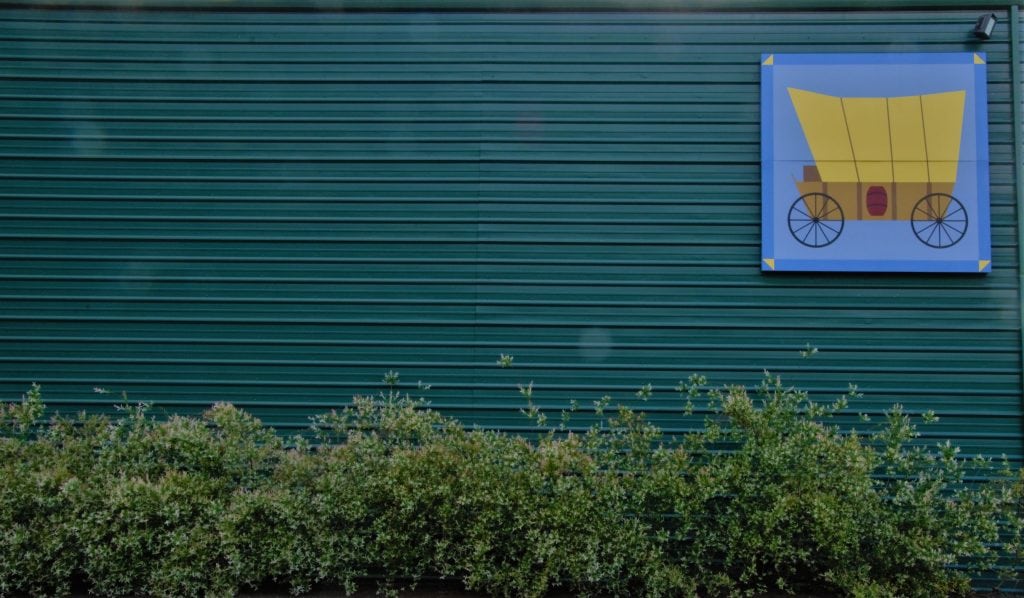
On the Petshow barn, a “Grandmother’s Flower Garden” block pays tribute to an heirloom Grandmother’s Flower Garden quilt made by Linda Petshow’s mother who had been a pioneer in nearby Washington State.
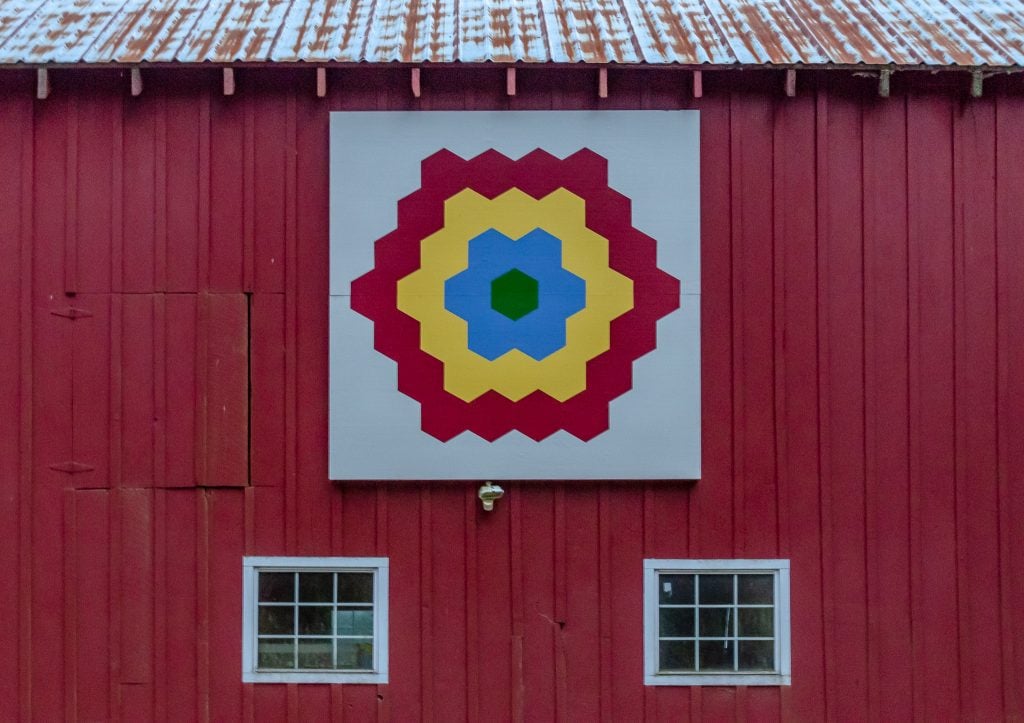
Not all the farms or the quilt barn blocks tell an old story. The “New York Beauty” block on the Blooming Hill Vineyard and Winery is a nod to owners Jim and Holly Witte’s roots in New York State.
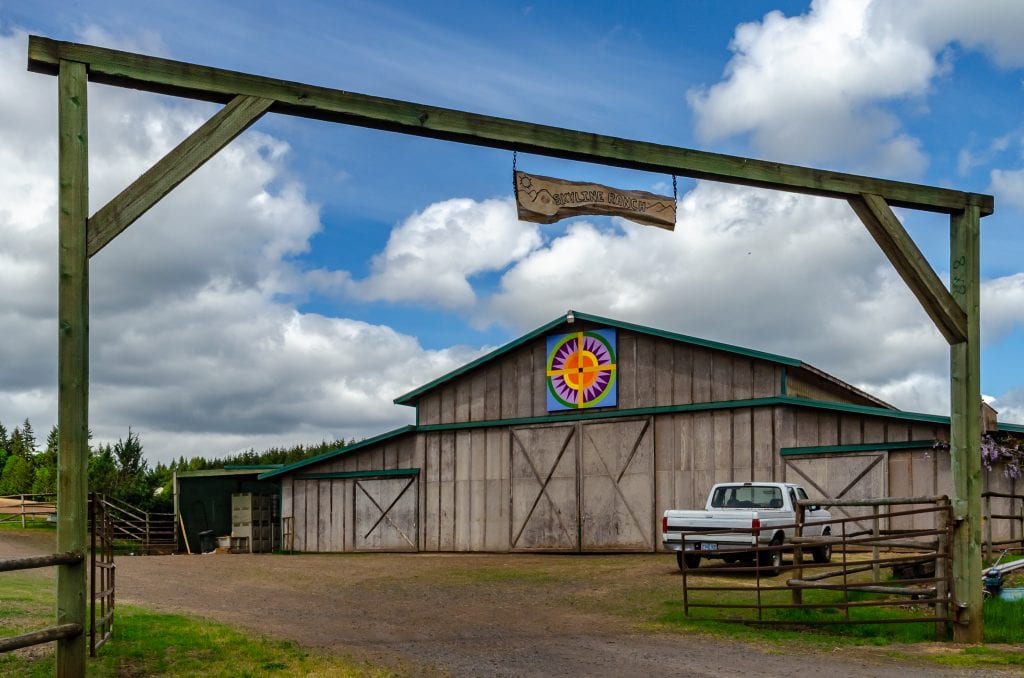
And at Twin Oaks Nursery, the “Sunflower” Block is right at home with the nursery’s other plants. While this barn is not that old, relatively speaking, it is no less historic. It is one of the “Government” barns that were built in the area after WWII. With some funds from the government along with a barn design, veterans from that war could put up a barn for minimal cost.
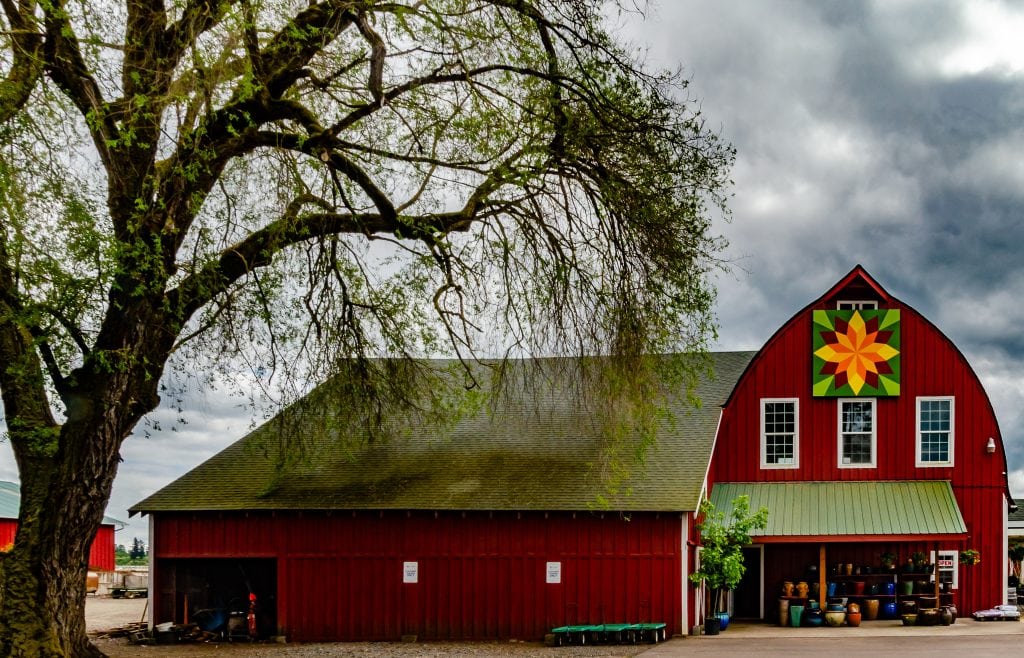
As I sat and continued chatting with Julie and Jane over an early cup of coffee, they mentioned that they were drafting a quilt barn block the next day and then hanging up two blocks on nearby barns the day after. Was I interested in observing the process? I jumped at the chance to be part of this unique first hand experience.
Early the next morning, I went to the Simpson Farm, the same one where the first Quilt Barn Trail block had been put up. Bev Hess, owner of the barn, had donated the space for the Quilt Barn Trail volunteers to use as their workshop. Looking around, it was clear that four years into the project, the group had developed an efficient system for building, priming, drafting and painting the quilt blocks. A special rack had been built to hold each 4 ft x 8 ft framed half of the block after it was primed so that it could dry cleanly. The paint table with about 30 different colors, was perfectly organized with dedicated buckets for paint sticks and brushes. Another rack held the plywood sheets waiting to be framed out. A set of rough shelves was organized with all the spare painting supplies. Clearly, they had learned that the key to working with a large group of volunteers was an orderly production system – I was quite impressed.

A Personal Quilt Barn Trail Story
The following day I met up with the group of volunteers at the Reichen family farm to watch as the 50th quilt block was hung. Molly and Roy Reichen’s excitement at having their quilt block put up was contagious. This was clearly a meaningful event for them.
Listening as Roy proudly told me about his family history, it was obvious that he has very strong ties to his heritage and to this land. This farm has been in the Reichen family for four generations- ever since Roy’s great-grandparents emigrated from Switzerland in 1890. They had settled here because the geography reminded them of the Bernese Alps that they had left behind. It was good land to be a dairy farmer and make Swiss cheese. Roy’s grandfather had sold that cheese in Portland. Though for Roy, being a farmer had not been a foregone conclusion. He had started out as an elementary school teacher, but then in 1975, he decided to start working the farm. Today he farms his own 38 acres as well as 300 acres that he rents and leases, with the primary crops being grass seed and wheat.
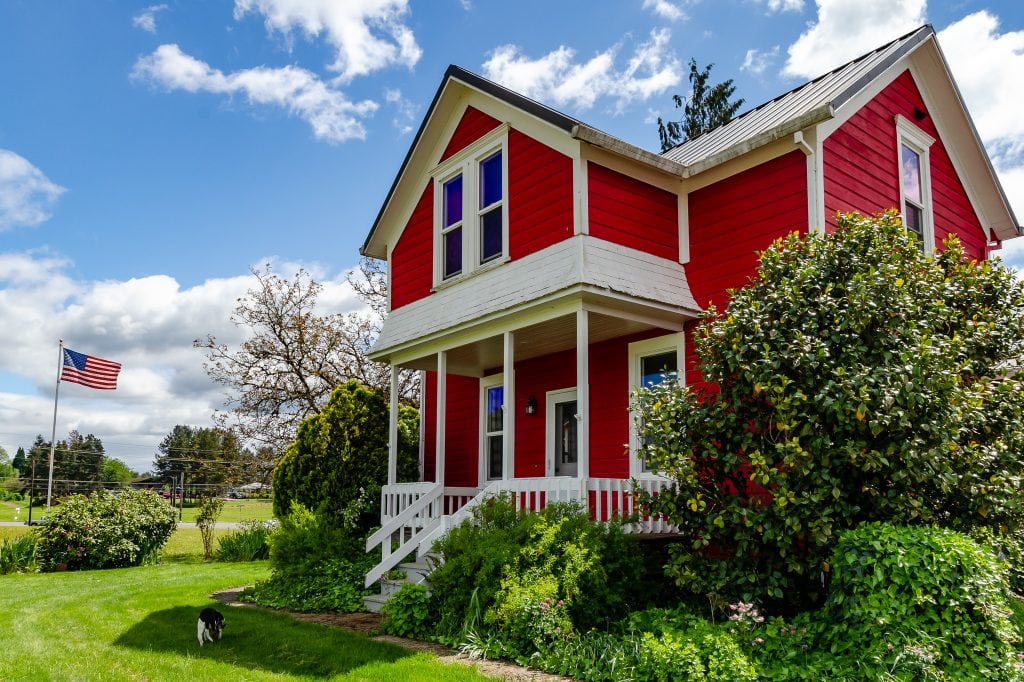
It was the farm’s crops that inspired the quilt block design for the Reichen barn. The block is called “Harvest Star” and the colors represent the red of the crimson clover that the farm also grows, the shades of yellow are for the wheat and the blue is for blueberries. The quilt block design had been a family affair, with Mollly, Roy, and Roy’s 95 year old mother, Lois, all providing input into the block’s design. And all three were there that day, watching with eager anticipation as the block was installed.
I also watched eagerly because I was curious to see how they would hang the two halves of the block so that the design matched up. Clearly, this process had been refined as well. John Doctor led the team of volunteers that was doing the installation. First one supporting frame was screwed onto the barn. Then using a jig to get the correct spacing, the second frame was attached.
The painted block halves were next. But before they were lifted up, the family and the volunteers signed the back of the panels. I was thrilled to be included in this ritual.
After a final polish to the surface, the two halves of the quilt barn block went up very quickly. First one half, then the other was placed over the frame and screwed on from the side so that the screws would not damage the design. One more quick polish once it was hanging, and the block was up and looking beautiful.
The bright colors contrasted nicely with the weathered surface of the old barn, and the red picked up the color of the nearby farmhouse. Roy and Molly proudly posed with their new addition.

Once the quilt barn block was up, Roy excitedly showed us around the farm and the family farmhouse that he and Molly were lovingly renovating. We fed the pet goats and their horse. I admired the vintage car that Roy and Molly had used in their wedding 13 years earlier. He proudly showed us the addition that he had built for Lois, so that she could continue to live in her ancestral home. Everywhere you looked there were little examples of his family history. Roy showed off an antique Grandmother’s Flower Garden Quilt that had been made by three generations of women in his family – his mother, grandmother and great-grandmother all had a hand in sewing the quilt. He also held up another quilt his mother had made for him from his old clothes when he was young. His connection to this land, to this home and to his heritage was palpable.
As I was getting ready to leave and was about to pull out of the driveway, Roy tapped on my car’s window. He wanted to offer me one more piece of his family heritage. One of his family members had recently started making cheese in the same tradition as his great-grandfather, and Roy was offering me a wedge to take home as a parting gift. I was extremely touched by this thoughtful gesture.
Julie Mason, Jane Fouste and their teams of volunteers should be very proud of the legacy they are creating with their Quilt Barn Trail, a legacy that celebrates the long history of farms in Oregon’s Tualatin Valley and farmers such as Molly and Roy Reichen. It was truly a pleasure to meet them and to share their story.
For up to date information on the Tualatin Valley Quilt Barn Trail, please visit http://quiltbarnswc.blogspot.com/
You can also read about where to stay, eat and play in the Tualatin Valley as you tour the quilt barn trail.
Please note that my visit to the Tualatin Valley Quilt Barn Trail was sponsored by the Washington County Visitor’s Association. All content and opinions are my own.
Thanks for visiting.
Rose
Pin this!
